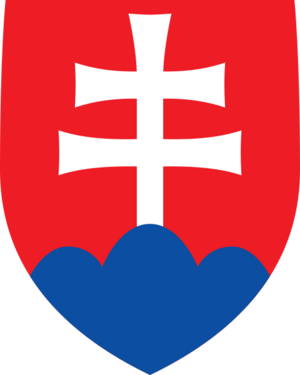Coat of arms of Slovakia facts for kids
The coat of arms of Slovakia is a very important national symbol. It shows a red shield with a silver double cross. This cross stands on the middle peak of a dark blue mountain that has three peaks. This design has a long history and tells a story about Slovakia's past.
Contents
What the Symbols Mean
The Slovak coat of arms is full of meaning. Each part, from the cross to the mountains and colors, represents something important about the country and its people.
The Double Cross
The double cross is the most striking part of the coat of arms. It has two horizontal bars, with the top one being shorter. This symbol first came to the region from the Byzantine Empire. It was brought by Christian missionaries like Saints Cyril and Methodius in the 9th century. They helped spread Christianity and writing among the early Slavic people.
The double cross became a symbol of the Great Moravian Empire. This was an important early Slavic state that included parts of modern-day Slovakia. Later, it was adopted by the Kingdom of Hungary, which ruled Slovakia for many centuries. For Slovaks, the double cross represents their Christian faith and their long history. It also reminds them of their ancient roots in the Great Moravian Empire.
The Three Mountains
Below the double cross, you can see three blue mountain peaks. These peaks represent three specific mountain ranges. They are the Tatra, Fatra, and Mátra mountains. The Tatra and Fatra mountains are still in Slovakia today. The Mátra mountains are now in Hungary.
Historically, these mountains were seen as important natural borders or features of the region. They symbolize the land and the natural beauty of Slovakia. The blue color of the mountains also adds to the overall look of the coat of arms.
The Colors: Red, Silver, and Blue
The colors used in the coat of arms are also very meaningful.
- The red shield is a common color in heraldry. It often represents bravery, courage, and strength.
- The silver (or white) color of the double cross stands for purity, peace, and honesty.
- The dark blue color of the mountains represents the rivers and skies of Slovakia. It also matches the colors of the flag of Slovakia.
Together, these colors form the pan-Slavic colors. These are red, white, and blue. Many Slavic nations use these colors in their flags and symbols. This shows a connection between Slovakia and other Slavic countries.
History of the Coat of Arms
The symbols on the Slovak coat of arms are very old. They have been used for hundreds of years.
Early Beginnings
The double cross first appeared in the region around the 9th century. It was used by the Great Moravian Empire. Later, it became a symbol of the Árpád dynasty, who were the first kings of Hungary. Because Slovakia was part of the Kingdom of Hungary for a long time, this symbol became important to Slovaks too.
Modern Use
Over the centuries, the design changed a little. But the main elements – the double cross and the three mountains – stayed the same. When Czechoslovakia was formed in 1918, the Slovak coat of arms was part of its national symbols.
After Slovakia became an independent country in 1993, it officially adopted this coat of arms. It is now a proud symbol of the Slovak Republic. You can see it on government buildings, official documents, and even on Slovak euro coins. It reminds everyone of Slovakia's rich history and its identity as a nation.
Images for kids
-
Saint Stephen, the first King of Hungary (1000–1038)
See also
In Spanish: Escudo de Eslovaquia para niños





